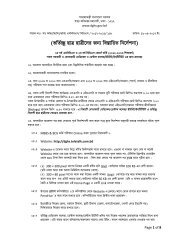Health Bulletin 2009
Health Bulletin 2009
Health Bulletin 2009
Create successful ePaper yourself
Turn your PDF publications into a flip-book with our unique Google optimized e-Paper software.
one MLSS. Number of USC is 1,362; that for UHFWC is 87. Under HPSP, Government planned<br />
for establishing one Community Clinic for every 6000 rural populations. Number of CCs so far<br />
built is 11,883. But, these were not made functional. Recently Government has decided to start<br />
the CCs again. The total number of CCs will be 18000. The existing UHCs and Union level<br />
facilities will also provide services of CCs in the respective communities. So,13,500 additional<br />
CCs will be required.<br />
The main health workforce in the union level is the domiciliary staff called health assistants.<br />
They are placed in each ward, which is the lowest and smallest administrative unit of the health<br />
sector. They visit the homes of the local people for providing primary health care services and<br />
collection of routine health data. The health assistants routinely organize satellite clinics for<br />
immunization services. Besides there are other small to large hospitals and special purpose<br />
hospitals spread across the country both in rural as well as in urban areas. Under the DGHS,<br />
there are altogether 40 teaching/training institutes and 589 small to large hospitals. In Family<br />
Planning sector, there are one national research-cum-training institute, two hospital-based<br />
training centres, and 32 other training centres (national: 12; regional: 20).<br />
Nearly six hundred health managers under DGHS and a similar number under DGFP, from<br />
national to upazila levels, play roles in administering the health and family planning services<br />
(1,17). This figure does not include the institute and clinic/hospital heads.<br />
<strong>Health</strong>, Nutrition & Population Sector Program (HNPSP)<br />
The constitution Bangladesh mandates for basic health care services for its people as one of<br />
the fundamental responsibilities of the state. Towards this goal, the government has taken<br />
different endeavors to extend health facilities to the population. The broader policy document of<br />
the Government of Bangladesh that shapes direction of health care is the Proverty Reduction<br />
Strategy Paper (PRSP) although the current government has indicated that it will go for Five-<br />
Year Plan. The Government of Bangladesh is running a program through which the health care<br />
services are provided to the people from the grass root to the central level. The program is<br />
entitled <strong>Health</strong>, Nutrition and Population Sector Program for the period of July 2003 through<br />
June 2010 (HNPSP 2003-2010). The Ministry of <strong>Health</strong> and Family Welfare (MOHFW) designed<br />
the Program Implementation Plan (PIP) in accordance with the PRSP to implement its sectorwide<br />
program popularly known as <strong>Health</strong>, Nutrition and Population Sector Program (HNPSP).<br />
The HNPSP covers 38 Operational Plans (OP) to be implemented by 38 Line Directors and 14<br />
Projects/Programs. The Government has recently decided to continue HNPSP until 2011. The<br />
details of the program are well documented in the form of Program Implementation Plan (PIP)<br />
duly endorsed at the highest policy level of the government, the Excecutive Committee for<br />
National Economic Council (ECNEC).<br />
The Implementing Agency of the program is Ministry of <strong>Health</strong> and Family Welfare (MOHFW)<br />
with its attached departments. The financial involvement is estimated to be around Taka<br />
324,503 million which includes contributions for GOB (Government of Bangladesh) and DPs<br />
(Development Partners).<br />
Priority Objectives and Goal<br />
One of the important goals of PRSP and HNPSP is attainment of Millennium Development<br />
Goals (MDGs). The health sector is specially striving for attainment of health related MDGs. The<br />
priority objectives of HNPSP are: (i) reducing MMR; (ii) reducing TFR; (iii) reducing malnutrition;<br />
(iv)reducing infant and under-five mortality;<br />
(v) reducing the burden of TB and other diseases; and (vi) prevention and control of noncommunicable<br />
diseases including injuries. The commitment of the government targets towards<br />
11


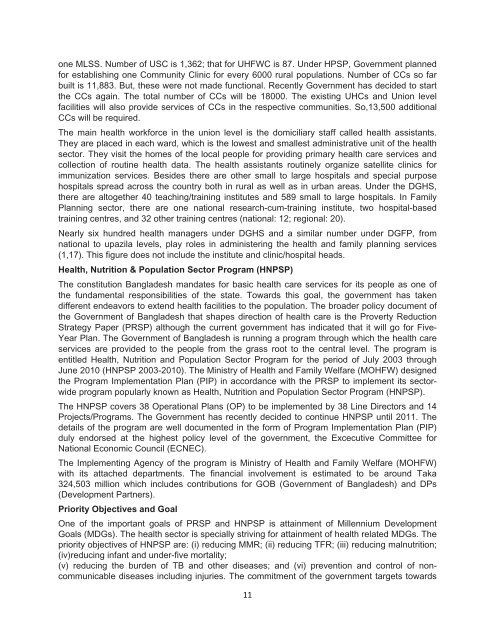
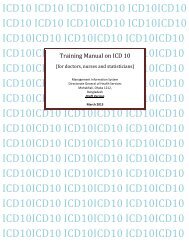




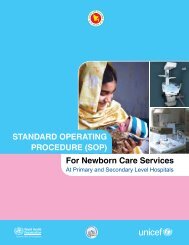
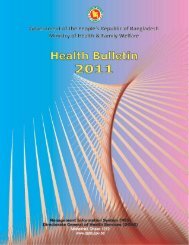
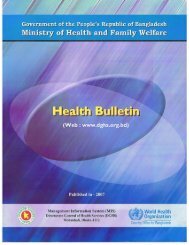
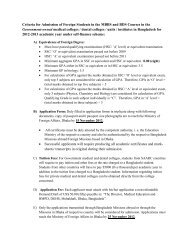
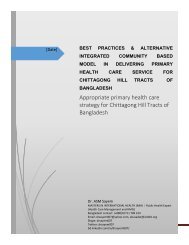
![Bangladesh Demographic and Health Survey 2007 [FR207]](https://img.yumpu.com/38440445/1/190x257/bangladesh-demographic-and-health-survey-2007-fr207.jpg?quality=85)
